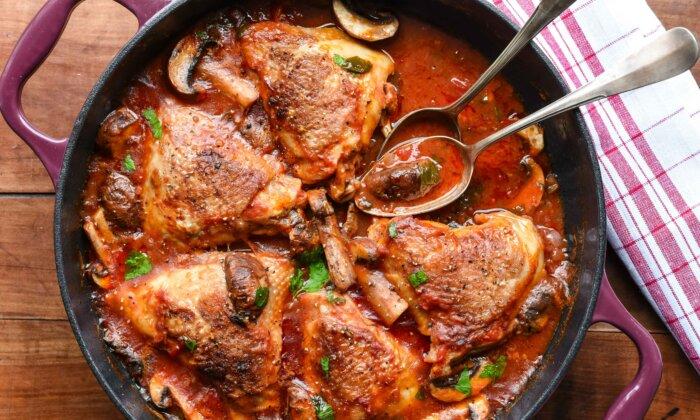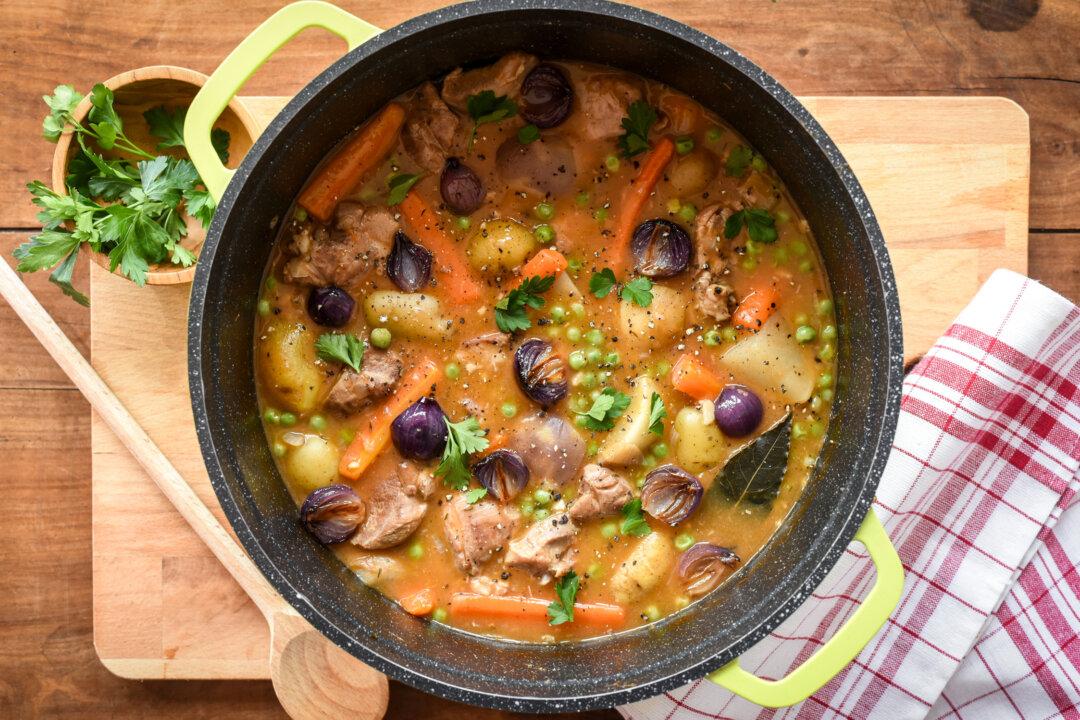On June 14, 1800, Napoleon Bonaparte and his French troops claimed victory over Austrian forces near the northern Italian village of Marengo. Napoleon, having won his first major victory as the First Consul of France, was famished.
He requested his personal chef, François Claude Guignet, nicknamed Dunan, create a dish fit for celebration. Dunan hurriedly improvised a recipe, sending the troop’s officers to find ingredients in the marshes and villages settled around the battlefield. One officer returned with tomatoes and fresh herbs, another with chicken and eggs, and a last one with crayfish that were fished from a swamp. Dunan concocted a hearty yet bright stew of chicken and tomatoes braised with white wine, livened up with orange zest, and garnished with fried eggs and crayfish.
It’s said that Napoleon loved the resulting dish so much that he asked Dunan to serve him the same meal before each of his future battles to bring him good luck on the battlefield. One day, as he was missing crayfish and eggs, the chef decided to swap them for seasonal mushrooms.
So goes the legend of chicken Marengo, the “victory chicken” dish that not only won Napoleon’s praise but also became a classic of the French culinary repertoire, still widely enjoyed today.

Battlefield to Table
Regardless of its true origins, the modern version of chicken Marengo is a simple, one-pot dish as fit for an emperor as for any home cook’s table. The eggs and crayfish are often omitted, substituted with mushrooms for a more affordable and approachable option, and the other ingredients are staples you likely already have on hand. Here are a few tips for choosing your ingredients wisely.The Chicken
Skin-on, bone-in chicken thighs are my pieces of choice for these types of wine-braised recipes. They’re so flavorful, and they turn fork-tender after braising.The Tomatoes
When in season, ripe tomatoes are best for this recipe, but you can opt for a can of whole tomatoes as well. Ideally, choose a variety of tomato that’s juicy and has soft, ripe flesh, such as plum or beefsteak.The Mushrooms
Cremini mushrooms are traditionally used for making this recipe, but you can opt for other seasonal mushrooms, such as porcini or chanterelles, if you would like.The Wine
Choose a white wine that’s dry and crisp, so it isn’t too overpowering. A “dry” white is any white wine that isn’t sweet, and a “crisp” white is a wine that has high acidity.Some of my recommendations are pinot grigio (neutral, easy to cook with, versatile), sauvignon blanc (bright acidity), and unoaked chardonnay (richer, with lovely citrus notes).
In any case, avoid opting for sweet white wines, such as riesling or sauternes, which will add too much sweetness to the finished dish. Also avoid full-bodied, rich, and/or oaky white wines, such as oaked chardonnay, which tend to develop bitter undertones when cooked.
The Orange Zest
Although it may be surprising to finish off a saucy mushroom and meat recipe with orange zest, it truly brings the whole dish together. It adds depth of flavor and brightens the dish, making it a perfect meal to transition from late summer to early fall.Chicken Marengo
A hearty yet bright stew, this is a recipe to enjoy year-round. You can remove the skin of the chicken thighs if you want a healthier version, but be warned that the skin lends a great deal of flavor to the sauce. This version includes canned whole tomatoes, but you can substitute the same amount of fresh, ripe tomatoes when they’re still in season. Serve the saucy finished dish over white rice with a side of green beans.- 6 chicken thighs, bone-in, skin-on
- 1/3 cup all-purpose flour
- 2 tablespoons unsalted butter
- 2 tablespoons extra-virgin olive oil
- 1 large onion, peeled and diced
- 2 garlic cloves, peeled and minced
- 7 to 8 sprigs flat-leaf parsley, stemmed and chopped
- 3/4 cup dry white wine
- 3/4 cup chicken stock
- 1 (28-ounce) can whole tomatoes (about 12 plum tomatoes), diced into small cubes, juice reserved
- 1 to 2 teaspoons fresh orange zest (depending on how strong you want it)
- 16 cremini mushrooms (white or brown), sliced
- Salt and pepper to taste
Season the chicken thighs with salt and pepper on both sides. Place the flour on a shallow plate and roll each chicken thigh in flour to cover it evenly.

Melt the butter in a large frying pan over medium heat. Add the chicken thighs skin side down and cook for 7 to 8 minutes on each side, until the skin is crisp and golden. Transfer the thighs to a plate.
Add the extra-virgin olive oil to the same frying pan, along with the diced onion, garlic, and parsley. Cook for 2 to 3 minutes, still over medium heat and stirring occasionally with a wooden spoon, until the onion is translucent.

Add the white wine and chicken stock to the pan and scrape off any bits at the bottom of the pan with a wooden spoon.
Stir in the diced tomatoes with their juice. Turn the heat to medium-high and bring to a simmer. Nestle the chicken pieces back into the sauce and turn the heat to medium-low (for a slow simmer). Simmer for 30 minutes, uncovered.

Stir in the orange zest, followed by the mushrooms, and simmer for 10 to 15 minutes more or until the mushrooms are cooked through. Taste the sauce and adjust the seasoning to your liking.
Serve immediately over white rice and a side of green beans.







